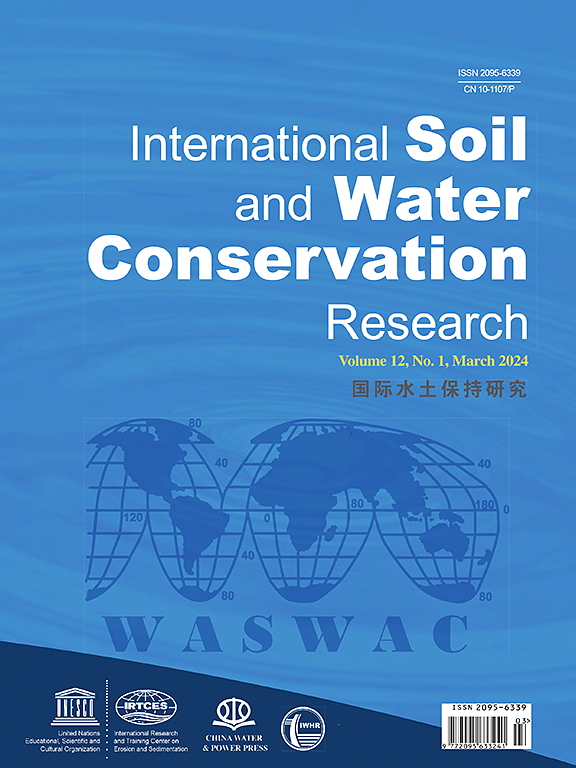Morphology evolution of vegetation-covered loess gully heads induced by hydraulic and gravitational erosion
IF 7.3
1区 农林科学
Q1 ENVIRONMENTAL SCIENCES
International Soil and Water Conservation Research
Pub Date : 2025-01-17
DOI:10.1016/j.iswcr.2025.01.003
引用次数: 0
Abstract
Gully heads suffer hydraulic and gravitational erosion triggered by rainstorms. However, how hydraulic and gravitational erosion affect the morphology evolution of the vegetation-covered loess gully heads is unclear. Field flow scouring and separation experiments were conducted to simulate the runoff and erosion processes of vegetation-covered gully heads subjected to concentrated flow on the Loess Plateau. The results show that the gully heads experienced early simplex hydraulic erosion and subsequent compound hydraulic and gravitational erosion under concentrated flow, resulting in the initiation, development, shrinkage, and reformation of the scour hole and plunge pool. In the early period, the rates of the scour hole widening and deepening had significant linear relationships with the on-wall flow rate (P < 0.01); moreover, among the hydraulic parameters of jet flow, the cumulative width and stable depth of the plunge pool had the highest significant correlations with the kinetic energy of the jet flow into the plunge pool (P < 0.01). Gravitational erosion contributed 26–50% and 0–26% to the maximum width and depth of the scour hole, respectively, and hydraulic erosion played a dominant role in scour hole development. Nevertheless, an overhanging mass collapse could reduce the depth and width of the plunge pool by 56–87% and 77–93%, respectively. The gully head retreated as a cyclic process of scour hole development, scour hole collapse (scour hole enlargement), overhanging mass collapse (scour hole shrinkage), and scour hole redevelopment. The mutual promotion of hydraulic erosion and gravitational erosion resulted in the sustained retreat of the vegetation-covered gully heads.
水力和重力侵蚀作用下植被覆盖黄土沟头形态演化
沟头受到暴雨引发的水力和重力侵蚀。然而,水力侵蚀和重力侵蚀如何影响植被覆盖的黄土沟头的形态演化尚不清楚。采用野外水流冲刷分离试验,模拟了黄土高原植被覆盖沟头在集中水流作用下的径流侵蚀过程。结果表明:沟头在集中水流作用下经历了早期单一的水力侵蚀和随后的水力和重力复合侵蚀,导致冲蚀孔和冲蚀池的形成、发育、收缩和改造;早期,冲刷孔扩深速率与壁面流速呈显著线性关系(P <;0.01);此外,在射流水力参数中,突水池的累积宽度和稳定深度与进入突水池的射流动能的相关性最高(P <;0.01)。重力侵蚀对冲刷孔最大宽度和深度的贡献分别为26 ~ 50%和0 ~ 26%,水力侵蚀对冲刷孔发育起主导作用。悬垂体崩塌可使滑塌池的深度和宽度分别减小56 ~ 87%和77 ~ 93%。沟头后退是冲刷孔发育、冲刷孔崩塌(冲刷孔扩大)、悬垂体崩塌(冲刷孔收缩)、冲刷孔再开发的循环过程。水力侵蚀与重力侵蚀相互促进,导致植被覆盖的沟头持续后退。
本文章由计算机程序翻译,如有差异,请以英文原文为准。
求助全文
约1分钟内获得全文
求助全文
来源期刊

International Soil and Water Conservation Research
Agricultural and Biological Sciences-Agronomy and Crop Science
CiteScore
12.00
自引率
3.10%
发文量
171
审稿时长
49 days
期刊介绍:
The International Soil and Water Conservation Research (ISWCR), the official journal of World Association of Soil and Water Conservation (WASWAC) http://www.waswac.org, is a multidisciplinary journal of soil and water conservation research, practice, policy, and perspectives. It aims to disseminate new knowledge and promote the practice of soil and water conservation.
The scope of International Soil and Water Conservation Research includes research, strategies, and technologies for prediction, prevention, and protection of soil and water resources. It deals with identification, characterization, and modeling; dynamic monitoring and evaluation; assessment and management of conservation practice and creation and implementation of quality standards.
Examples of appropriate topical areas include (but are not limited to):
• Conservation models, tools, and technologies
• Conservation agricultural
• Soil health resources, indicators, assessment, and management
• Land degradation
• Sustainable development
• Soil erosion and its control
• Soil erosion processes
• Water resources assessment and management
• Watershed management
• Soil erosion models
• Literature review on topics related soil and water conservation research
 求助内容:
求助内容: 应助结果提醒方式:
应助结果提醒方式:


